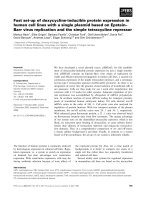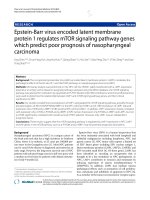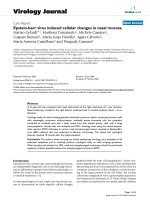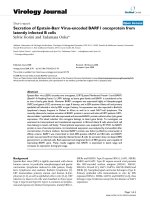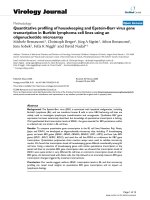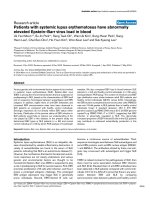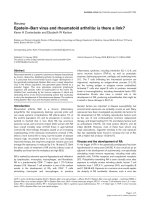Epstein barr virus episome replication and transcription
Bạn đang xem bản rút gọn của tài liệu. Xem và tải ngay bản đầy đủ của tài liệu tại đây (3.89 MB, 157 trang )
EPSTEIN-BARR VIRUS EPISOME
REPLICATION AND TRANSCRIPTION
AW YONG KOH MENG
NATIONAL UNIVERSITY OF SINGAPORE
2006
EPSTEIN-BARR VIRUS EPISOME
REPLICATION AND TRANSCRIPTION
AW YONG KOH MENG
B.Sc. (Hons), NUS
A THESIS SUBMITTED
FOR THE DEGREE OF MASTER OF SCIENCE
DEPARTMENT OF MICROBIOLOGY
NATIONAL UNIVERSITY OF SINGAPORE
Acknowledgements
I would like to take this opportunity to thank my supervisor, Dr Hung Siu Chun for
guiding me all this time, even though he is no longer in NUS. I am grateful for all that
he has taught me as well as for all the support that he has shown.
I would also like to thank A/Prof. Mary Ng for agreeing to my co-supervisor and Prof.
Chan for allowing me to stay in the WHO Immunological Centre to finish my work.
Special thanks to Shyue Wei and Gayathri; you guys have been wonderful.
A big thank you to my wife Yee Sun who has been giving me her unwavering support
through this difficult time; you are the best! Not forgetting my family and friends who
have all stood behind me supporting me all the way.
i
Table of contents
Page
Acknowledgements
i
Table of contents
ii
List of figures
vii
List of tables
ix
Abbreviations
x
Summary
xii
1.
Introduction
2.
Survey of literature
2.1
2.1.1
DNA replication
7
Prokaryotic DNA replication
7
2.1.1.1 Origin of replication in prokaryotes
2.1.2
1
Eukaryotic DNA replication
8
9
2.1.2.1 Origin of replication in Saccharomyces cerevisiae
10
2.1.2.2 Origin of replication in Drosophilia melanogaster
12
2.1.2.3 Origin of replication in mammalian cells
14
2.2
Epstein-Barr Virus
17
2.2.1
Epstein-Barr Virus latent origin of replication oriP
18
2.2.2
EBNA-1 protein
19
2.2.2.1 Role of EBNA-1 in the persistence of any plasmids bearing
oriP
2.2.2.2 Use of Epstein-Barr Virus based gene therapy vector
2.3
20
21
Transcription
24
2.3.1
Prokaryotic transcription
25
2.3.2
Eukaryotic transcription
26
ii
2.3.2.1 RNA polymerase II
2.4
2.4.1
2.4.2
3.
27
Relationship between DNA replication and transcription
30
Transcription through an origin of replication may inhibit
DNA replication
Transcription factors may affect DNA replication positively
30
32
Materials and Methods
3.1
Polymerase Chain Reaction (PCR) amplification of EBV
origin of replication oriP
35
3.1.1
PCR reaction setup
35
3.1.2
Gel purification of PCR products
36
3.1.3
Non-gel based purification of enzyme reaction
37
3.2
Restriction enzyme analysis
37
3.3
Filling in of 5’ overhangs and removal of 3’ overhands of
restriction-digested plasmid
38
3.4
Ligation of the insert and plasmid vector
38
3.5
Manipulation of Escherichia coli DH10B strain
39
3.5.1
Preparation of electrocompetent DH10B cells
39
3.5.2
Electro-transformation of electrocompetent DH10B cells
40
3.5.3
Preparation of small amount of plasmid
40
3.5.4
Preparation of bigger amount of plasmid
41
Maintenance and manipulation of B95-8 or BJAB cell line
41
3.6.1
Cell count using hemocytometer
42
3.6.2
Extraction of genomic DNA from B95-8
42
3.6.3
Transfection of B lymphocyte cell lines B95-8n and BJAB
43
3.6
3.6.3.1 Optimization of transfection efficiency
3.7
3.7.1
43
Southern and Northern blot analysis
44
Transfection of B95-8 and BJAB cells
44
iii
3.7.2
3.7.3
Isolation of whole cell RNA and DNA from transfected
samples
Preparation of labeled probes
44
45
3.7.3.1 Reverse transcription PCR
46
3.7.3.2 Purification of cDNA products
47
3.7.3.3 Labeling reaction
47
3.7.4
Southern blot
47
3.7.5
Northern blot
50
3.7.6
Reprobing of membrane
52
In-vitro transcription
53
In-vitro transcription optimization experiment
53
3.8
3.8.1
3.8.1.1 Preparation of template DNA
54
3.8.1.2 Time course study
54
3.8.1.3 rNTP concentration optimization experiment
54
3.9
Size exclusion chromatography
55
3.9.1
Packaging and calibration of the column
55
3.9.2
Loading of the sample onto column
56
3.9.2.1 Collection of fractions and nucleic acid precipitation
4.
56
Results
4.1
4.1.1
Replication of EBV oriP-containing plasmids in EBNA-1
expressing cells
58
Construction of oriP-containing plasmids
63
4.1.1.1 Amplification of oriP DNA
63
4.1.1.2 pcDNA 3.1+
65
4.1.1.3 p-oriP-S
66
4.1.1.4 p-S-oriP and p-S-oriP.1
67
4.1.1.5 p-oriP-∆S
70
iv
4.1.2
Replication of p-oriP-S in EBNA-1 expressing cells
71
4.1.3
Replication of oriP containing plasmids is negatively
influenced by the presence of transcription promoter in the
replicon
74
Transcription through oriP is inhibited in vivo
76
Transcription through oriP in vivo is inhibited even in the
absence of EBNA-1
79
In vitro transcription of oriP-containing template
81
In vitro transcription of pcDNA3.1+, p-oriP-S, p-S-oriP, p-SoriP.1 and p-oriP-∆S
81
Construction of templates for analysis of transcription arrest
in vitro
85
4.4.1
p-E-lacZ
88
4.4.2
p-E-oriP
90
In vitro transcription of p-E-lacZ and p-E-oriP
91
Transcription arrest under shortage of substrates
95
Size exclusion chromatography able to separate DNA/RNA
according to size
96
4.6.1
Unimpeded transcription
98
4.6.2
Column is capable of excluding artificially induced arrested
RNA polymerase
99
4.6.3
OriP induces transcriptional termination, rather than arrest,
in pEGFP-oriP
100
4.2
4.2.1
4.3
4.3.1
4.4
4.5
4.5.1
4.6
5.
Discussion
5.1
Inhibition of oriP replication function is dependent on the
presence of promoter
102
5.2
Transcription through oriP was inhibited
102
5.3
Something else other than transcriptional arrest causes
replication inhibition
105
5.4
Passage of transcription machinery could prevent replication
106
v
initiation
5.5
Chromatin remodeling could also affect replication
108
5.6
Future directions
112
5.7
Conclusions
114
References
116
Appendices
127
vi
List of figures
Page
Figure 1
Prokaryotic replication initiation
9
Figure 2
Eukaryotic replication initiation
12
Figure 3
Schematic representation of EBNA-1
21
Figure 4
A basic EBV based vector
23
Figure 5
56
Figure 6
Schematic diagram of column for size exclusion
chromatography
Map of plasmid pcDNA3.1+
Figure 7
Map of plasmid p-oriP-S
60
Figure 8
Map of plasmid p-S-orip
61
Figure 9
Map of plasmid p-S-oriP.1
62
Figure 10
Map of plasmid p-S-oriP-∆S
63
Figure 11
Map of ori containing EBV genomic fragment to be PCR
amplified and cloned in this study
64
Figure 12
PCR amplified oriP-containing EBV genomic fragment
64
Figure 13
Restriction analysis of pcDNA3.1+
65
Figure 14
Restriction analysis of p-oriP-S
67
Figure 15
Restriction analysis of p-S-oriP and p-S-oriP.1
69
Figure 16
Restriction analysis of p-S-oriP-∆S
70
Figure 17
Kinetics of replication of p-oriP-S in EBNA-1 expressing cells
73
Figure 18
Replication efficiencies of pcDNA3.1+ derived oriP-containing
plasmids
75
Figure 19
Transcription of pcDNA3.1+-derived oriP-containing plasmids
in B95-8 cells
77
Figure 20
Transcription of pcDNA3.1+-derived oriP-containing plasmids
in BJAB cells
80
Figure 21
In vitro transcription templates and expected transcripts from
pcDNA3.1+-derived oriP-containing plasmids
82
59
vii
Figure 22
Transcription of pcDNA3.1+-derived oriP-containing plasmids
in vitro
84
Figure 23
Map of pEGFP-C1
86
Figure 24
Map of plasmid p-E-lacZ
87
Figure 25
Map of plasmid p-E-oriP
88
Figure 26
Gel photos of p-E-lacZ restriction enzyme analysis
89
Figure 27
Gel photo p-E-oriP restriction enzyme analysis
90
Figure 28
Linear maps of plasmids
92
Figure 29
Northern blot analysis of in vitro transcription
93
Figure 30
Transcription arrest under shortage of substrates
95
Figure 31
Gel analysis of size exclusion chromatography using λ Hind
III DNA ladder
97
Figure 32
Gel analysis of size exclusion chromatography of RNA ladder
97
Figure 33
Northern blot analysis of size exclusion chromatography of in
vitro transcription
98
Figure 34
Exclusion chromatography of artificially arrested in vitro
transcription
100
Figure 35
Northern blot analysis of size exclusion chromatography of in
vitro transcription
101
viii
List of tables
Page
Table 1
PCR reaction for amplifying oriP
36
Table 2
PCR reaction conditions
36
Table 3
T4 DNA polymerase reaction mix
38
Table 4
Ligation reaction mix
39
Table 5
RNase-free DNase I digestion mic
45
Table 6
RT-PCR reaction mix
46
Table 7
One-step RT-PCR thermal cycler conditions
46
Table 8
Reaction mix for labeling reaction
47
Table 9
Reaction mix for in-vitro transcription
53
Table 10
Plasmids designed for in vivo study of effect of transcription
on oriP dependent replication
58
ix
Abbreviations
ACE
Amplification control element
AER
Amplification enhancing region
ARS
Autonomously replicating sequence
bp
Base pairs
CMV
Cytomegalovirus
DHFR
Dihydrofolate reductase
DS
Dyad symmetry
EBNA-1
Epstein-Barr nuclear antigen-1
EBV
Epstein-Barr virus
FR
Family of repeats
kb
Kilobase pairs
LB
Luria Bertani
MCM
Minichromosome maintenance
NTPs
Nucleotide triphosphates
ORC
Origin recognition complex
PCR
Polymerase chain reaction
Pre-RC
Pre-replicative complex
RPA
Replication protein A
SV40
Simian virus 40
TAF
TBP associated factor
TBP
Transcription binding factor
TEC
Transcription elongation complex
UV
Ultra-violet
x
α
Alpha
β
Beta
γ
Gamma
κ
Kappa
λ
Lambda
ω
Omega
xi
Summary
The relationship between transcription and replication has not been fully understood.
In this study I aim to understand more about this relationship by making use of the
EBV latent origin of replication oriP. OriP is able to initiate replication in the
presence of the EBV protein EBNA-1 by recruiting the cellular replication machinery,
therefore making it a suitable candidate for this study. Firstly, oriP was inserted onto a
vector and placed under the transcriptional effect of a promoter at various locations
within and without a transcriptional unit. The vectors were transfected into EBNA-1
expressing cells and the replication assayed using Southern blot. In addition, total
RNA was also extracted and analyzed using Northern blot. Southern blot results
indicated that the presence of a promoter upstream of oriP displayed the strongest
replication inhibition. Interestingly, Northern blot results indicated that there was a
lack of oriP containing transcripts both in the presence and absence of EBNA-1,
suggesting that oriP could have an inhibitory effect on transcription. In an attempt to
confirm the inhibitory effect of oriP on transcription, in vitro transcription was
performed, and results obtained were similar to those obtained in vivo. There were a
few possible explanations for these observations. One of which was that transcription
arrest occurred as the transcriptional machinery read through oriP. This state of
transcriptional arrest would explain for the lack of oriP containing transcripts and at
the same time; the physical stalling of the machinery along the template could have
inhibited replication by preventing the replication initiation machinery from
assembling on oriP. To test this possibility, we used size exclusion chromatography of
in vitro transcription reactions to differentiate between arrested transcripts trapped
with RNA polymerase and free transcripts. The results were consistent with the
dissociation of transcription elongation complex at oriP. Thus, the hypothesis of
xii
transcriptional arrest was not supported and the mechanism by which transcription
inhibits replication remains uncertain.
xiii
Introduction
Introduction
1. Introduction
The interplay between DNA replication and transcription has long been a focal point
of debate between researchers. Various works done by different groups have thrown
up different observations and conclusions, each of them seemingly contradicting the
other. While some claim that transcription inhibits replication, others propose that
transcription is necessary for replication. In this study we attempt to cast this
relationship in better light by employing the use of a known viral origin of replication,
the oriP, from the DNA herpesvirus, Epstein Barr Virus (EBV). But before we talk
about the relationship between these two cellular processes, we should first look at
them individually and examine what are some of the basic mechanisms that govern
and control them.
The bacterial DNA replication system was one of the pioneer models that contributed
to our understanding of DNA replication (Jacob et al. 1963). In this model, it was
proposed that two elements were required for the initiation of DNA replication: a
replication initiator protein and a cis-acting DNA element. Only when the replication
initiator protein binds to the cis-acting DNA element can DNA replication initiate and
proceed. Further work employing the use of the bacterial chromosome finally
elucidated this initiator protein to be a DNA binding protein called DnaA. Multiple
binding sites for DnaA could be found on the cis-acting DNA element, identified as
an origin of replication, oriC (Baker and Bell, 1998; Kornberg and Baker, 1992).
So far, DNA replication system in simple eukaryotes such as Saccharomyces
cerevisiae seems to bear some similar characteristics to the prokaryotic model in the
sense that both require an initiator and a cis-acting DNA element. Both utilize a DNA
1
Introduction
polymerase to synthesize the new strand of DNA from the template strand by adding
nucleotides to the 3’-OH end. But that is where the similarities probably end. The
complexity and the size of the eukaryotic genome far surpasses that of prokaryotes
and the initiator protein consists of different proteins arranged in a complex, called the
origin recognition complex (ORC) (Bell, 2002). And the difference is even more
obvious in higher order eukaryotes. To solve the problem of having to replicate such a
large genome, these eukaryotic organisms are also able to initiate DNA synthesis at
multiple sites (Huberman and Riggs, 1968). Another major difference lies in the fact
that DNA replication only occurs exclusively in the S phase of these higher order
eukaryotic cell cycle as compared to prokaryotes, which occur throughout the
bacterial life cycle. This would also mean that DNA replication in eukaryotes is more
tightly regulated.
Epstein-Barr Virus (EBV) is a DNA virus that exists as an extrachromosomal episome
during its latent stage of infection. Its ability to persist in infected cells latently can be
attributed to two viral components, the latent origin of replication oriP and the viral
nuclear antigen, EBV Nuclear Antigen-1 (EBNA-1). OriP contains multiple EBNA-1
binding sites, and with the help of bound EBNA-1, help recruit cellular proteins
necessary for DNA replication. This enables the virus to replicate its genome together
with the cell during the S phase, resulting in one copy of each viral replicon being
produced per cell cycle (Kieff and Rickinson, 2001). In fact, this particular
characteristic of the EBV has been employed in the construction of episomal gene
therapy vectors. Episomal gene therapy vectors based on EBV already show great
promise in treating disorders like Duchenne Muscular Dystrophy (Tsukamoto et al.,
1999). But for such vectors to be successful, efficient replication of the vector and the
2
Introduction
expression of the therapeutic gene that is carried on the vector must occur. Therefore,
a better understanding of the relationship between replication and transcription of an
oriP-dependent episome is critical for the optimal design of such vectors. Therefore,
the issue addressed in this work is of practical significance besides being an
interesting subject in basic molecular biology and virology.
Transcription in prokaryotes occurs in three main steps: initiation, elongation and
termination. Initiation first occurs when the RNA polymerase complex binds to the
promoter region. Elongation proceeds soon after with the RNA polymerase moving
along the DNA template, adding ribonucleotides to the 3’-OH end of the forming
RNA transcript and termination occurs when the RNA polymerase meets terminator
sequences or when a termination signal protein binds to the RNA polymerase. In
prokaryotes, one form of RNA polymerase is apparently responsible for the synthesis
of all RNA.
In eukaryotic cells, transcription also requires the three main steps as described for the
prokaryotic system. However, it was further described that the initiation stage can be
further broken down into another three distinct phases, namely the preinitiation,
initiation and promoter clearance (Sims et al. 2006). Differences between prokaryotic
and eukaryotic transcription systems also include the fact that the eukaryotic system
possesses three different RNA polymerases instead of one. They are RNA polymerase
I, RNA polymerase II and RNA polymerase III, each of which transcribe a different
set of genes. Furthermore, post-transcriptional processing of the RNA transcript such
as alternative splicing in eukaryotic cells allow for a larger repertoire of proteins to be
synthesized from a single strand of mRNA.
3
Introduction
As both transcription and replication utilize the same source of DNA template, there
is the inevitable question of whether any conflicts between these two processes could
arise. Indeed there have been works describing the physical collision between the
RNA polymerase and DNA polymerase in bacterial cells (Brewer, 1988). Haase et al.
(1994) have also shown that transcription through a known mammalian origin of
replication inhibits the ability of the plasmid carrying the origin to replicate. A similar
observation can also be extended to another eukaryotic organism, Saccharomyces
cerevisiae, where transcription through the autonomously replicating sequences (ARS)
inhibits the ability the ARS’s ability to activate replication (Tanaka et al., 1994).
On the other hand, it has been known for some time that regions of chromatin that are
transcriptionally active replicate earlier than transcriptionally inactive regions
(Stambrook and Flickinger, 1970; Goldman et al., 1984; Taljanidisz et al., 1989;
Gilbert, 2002). Genome-wide analysis of replication and transcription timing in
Drosophila have drawn the conclusion that there exits a strong correlation between
DNA replication and transcription (Schübeler et al., 2002; MacAlpine et al., 2004).
Analysis studies done on the human genome have drawn very similar conclusions,
providing a strong indication that transcription may be essential for replication
(Woodfine et al. 2004; White et al. 2004). In addition, Boucher et al. (2004) have
shown that transcription was required to ensure the replication and faithful
partitioning of plasmids in Leishmania donavani.
To aid our study of the relationship between replication and transcription, we decided
to utilize the EBV latent origin of replication, oriP. In addition to the reason stated
4
Introduction
above, oriP has also been shown, in the presence of EBNA-1 to recruit cellular
replication machinery and this most likely allows the virus to replicate its genome
during the latent stage of infection by recruiting the human origin recognition
complex to the oriP (Chaudhuri et al., 2001; Dhar et al. 2001; Schepers et al. 2001).
Therefore it is a suitable candidate for our study. We cloned oriP onto a vector
containing a SV40 promoter in varying positions from the SV40 and transfected these
clones into EBNA-1 expressing cells for a short term replication assay. Southern blot
results indicated that vectors with oriP immediately downstream of the SV40
promoter showed the most inhibition of replication, regardless of the orientation of
the oriP. Total RNA was also analyzed to study if transcription through the oriP of
these clones were affected as well. Interestingly, preliminary Northern blot results
also indicated that the clones that exhibited the most replication inhibition also
displayed the most inhibition of transcription through the oriP.
These preliminary findings seem to indicate that the relationship between replication
and transcription is a possibly one of a negative nature. One possible explanation was
that for transcription to inhibit replication, the transcription complex would have to
prevent the replication complex from assembling on the origin of replication. It could
be possible that transcription was arrested at the origin of replication as the
transcription complex transverses along the DNA template. This state of arrest would
likely cause the complex to be immobilized and prevent the movement of other
transcription complexes, resulting in the saturation of transcription complexes on the
DNA template and preventing the initiation of replication. Transcriptional arrest
would also explain the lack of oriP containing transcripts in the oriP containing
vectors. If this hypothesis is proven to be correct, it could potentially offer a novel
5
Introduction
method by which the persistence of episomal gene therapy vectors based on viruses
such as the Epstein-Barr virus (EBV) can be regulated.
To determine if inhibition of transcription was due to the physical arrest of the
transcription complex on the DNA sequence, we attempted to isolate the complex
with the arrested transcript using in-vitro transcription and size exclusion
chromatography. Preliminary in-vitro transcription experiments also indicated that
transcription was also inhibited for clones containing oriP immediately downstream
of the promoter. However, size exclusion chromatography failed to isolate any RNA
polymerase-arrested transcript complex, indicating that there is most likely no form of
physical arrest of the transcription complex on the DNA template.
The failure to isolate any RNA polymerase-arrested transcript is an indication that
termination of transcription rather than arrest most likely occurred as the transcription
complex met the oriP. If that is the case, our stand that the arrest of the transcription
complex along the DNA template prevents the DNA replication complex from
recognizing and binding to the oriP, thereby inhibiting replication should be reexamined. There are other potential directions that could be explored in the future to
help in the further understanding of the interplay between transcription and DNA
replication. One of them is chromatin remodeling.
6
Survey of literature
Survey of Literature
2. Survey of Literature
2.1 DNA replication
DNA replication is a fundamental process in any living organism. It is also a highly
complex procedure with different enzymes being involved at different stages of the
process. There are three main stages for replication: initiation, elongation and
termination. During initiation of replication, a protein complex first recognizes and
binds to a site on the DNA template. The double-stranded parental DNA at that site is
then separated into single strands, called the replication fork. Before elongation can
occur, priming must first occur by the synthesis of a short RNA primer, a nick in
DNA or a small priming protein. Elongation of the daughter DNA strand is carried
out by the DNA polymerase bi-directionally and involves the addition of nucleotides
to the growing 3’-OH end. This results in a newly synthesized DNA strand being
base-paired with the parental strand. This is also called semi-conservative DNA
replication. Termination of replication usually occurs when replication is completed.
Resolution of the replicated double stranded DNA from one another is required for
further partitioning into daughter cells. This section will focus more on the initiation
of replication.
2.1.1 Prokaryotic DNA replication
Prokaryotes usually contain only one replicon that exists as a closed circular DNA.
One of the most extensively studied replication system in prokaryotes is in
Escherichia coli, a Gram-negative bacteria.
7
Survey of Literature
2.1.1.1 Origin of replication in prokaryotes
Jacob et al. (1963) first proposed the idea that for DNA replication in bacteria to
proceed, two things are first required: a trans-acting initiator protein and a cis-acting
element at which DNA replication starts. Initiation of replication in Escherichia coli
occurs at a specific sequence of DNA in the replicon, known as oriC. OriC in turn
contains multiple binding sites for the initiator protein DnaA, which was arranged as a
huge multi-subunit protein complex surrounding oriC (Bramhill and Kornberg, 1988;
Kornberg and Baker, 1992; Baker and Bell, 1998). The DnaA complex bound to oriC
serves two purposes in replication: it first helps to unwind the surrounding DNA it is
located on and it ultimately recruits helicases to the origin of replication via binding to
loading factors. In Escherichia coli, the loading factors DnaC are found as a complex
with DnaB, with six molecules of DnaC binding with six molecules of DnaB as a
multimer. In this form, the bound DnaB is inactive for its helicase activity and only
upon the binding of DnaC-DnaB complex to the DnaA, is DnaB released from DnaC
in an ATP dependent manner (Wahle et al., 1989). DnaB further unwinds the DNA
and at the same time activates a primase, DnaG, which synthesizes short RNA
primers required for the DNA replication to proceed. A representative diagram of
replication initiation for prokaryotes is shown in figure 1 below.
8
